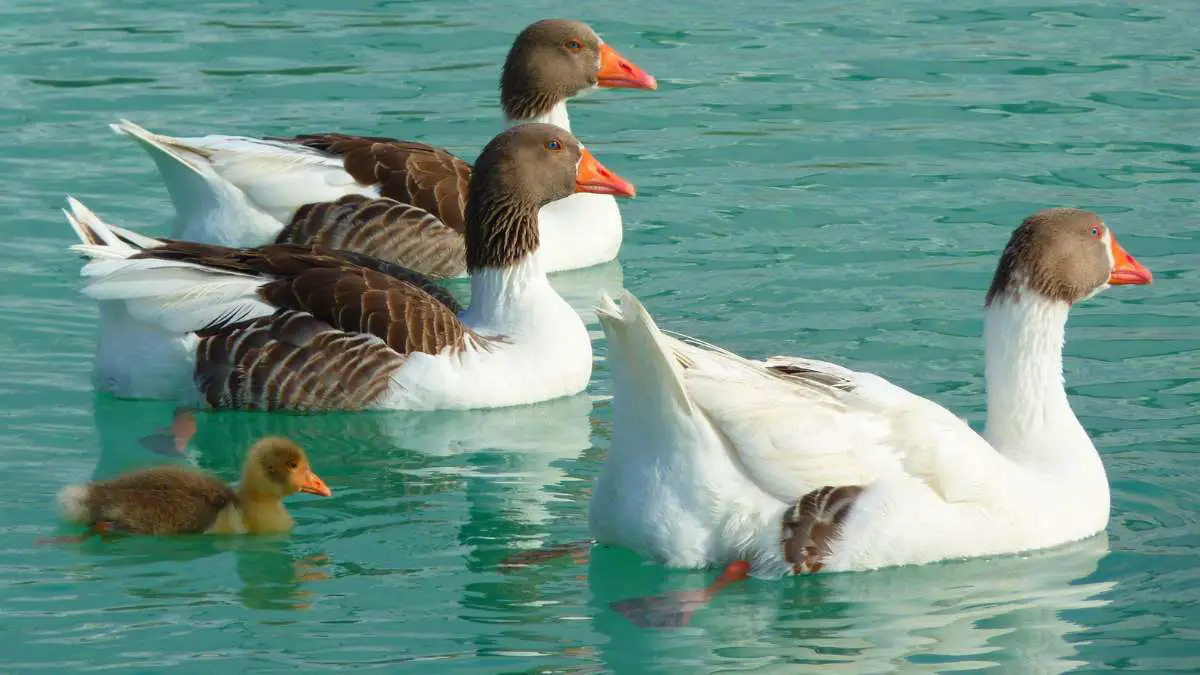Have you ever wondered if geese can swim? The answer is a resounding yes! These birds are not only adept swimmers but also built for aquatic life.
Webbed Feet and Hydrodynamic Features
Geese boast webbed feet, a bit like flippers on a penguin. These webbed wonders make them exceptional swimmers, allowing them to glide through the water with ease.
The webbing between their toes acts like paddles, propelling them gracefully. Moreover, their streamlined bodies reduce water resistance, making swimming even more efficient.
But the story doesn’t end with webbed feet. Geese have a few more tricks up their feathers.
Their plumage comes equipped with waterproofing abilities. This means they can dive and paddle while keeping their bodies dry, an essential trait for spending time in the water.
Buoyancy and Floating
Have you ever seen geese effortlessly floating on the water? This buoyancy is thanks to their air sacs. These air sacs within their bodies help them stay afloat, much like a life jacket.
Geese can control the amount of air in these sacs, allowing them to adjust their buoyancy and float on the water’s surface without sinking.
So, there you have it. Geese not only swim but do so quite skillfully, thanks to their webbed feet, hydrodynamic features, and buoyant air sacs.
The next time you spot a group of geese on a tranquil pond or river, take a moment to admire their graceful aquatic abilities.
The Behavioral Aspects of Geese in Water
When it comes to geese and water, there’s more than meets the eye. These remarkable birds showcase fascinating behaviors in aquatic settings.
Natural Habitats for Geese
Geese have a knack for choosing their water-based homes. You can often find them gracing the shores of lakes, meandering along rivers, or leisurely paddling in ponds.
But what’s truly remarkable is their migratory journey. Geese are known for their impressive travels, adapting to various aquatic environments during migration.
They seamlessly transition from one water source to another, proving their water-loving versatility.
Feeding and Foraging in Water
Geese aren’t just water enthusiasts; they’re also skilled foodies when it comes to aquatic environments. They use water as a bountiful buffet, with their diet consisting of aquatic plants, algae, and small invertebrates.
Watching them dip their heads beneath the surface to forage for these underwater treats is a sight to behold. Geese’s feeding habits in aquatic environments are both efficient and essential for their survival.
The Swimming Abilities of Geese
When it comes to swimming, geese are more than just beginners; they’re experts in the water world.
Swimming Techniques
Geese have a repertoire of swimming techniques up their feathered sleeves. They paddle gracefully, moving their webbed feet in perfect unison to glide effortlessly across the water.
Floating comes naturally to them as well. They can sit serenely on the water’s surface, buoyant and at ease. Navigating in the water is a skill they’ve mastered, using a combination of wing flaps and footwork to move in the desired direction.
Geese are like the swan’s confident cousin when it comes to swimming, showing off their proficiency in different swimming styles.
Speed and Agility
When it comes to speed and agility, geese don’t disappoint. They can pick up the pace when needed, reaching impressive speeds for a bird.
This agility and speed are essential for their survival, whether it’s evading predators or traveling long distances during migration. They use their swimming skills to swiftly cover distances, making them versatile and adaptable in various aquatic situations.
In a nutshell, geese are no strangers to the water. Their swimming abilities, including techniques and speed, are a testament to their adaptability and prowess in aquatic environments.
So, the next time you spot a group of geese gliding across a pond or river, take a moment to appreciate their graceful and agile swimming skills.
Geese in a Conservation Context
As we explore the question of whether geese swim, we discover not only their impressive swimming abilities but also their significant role in the conservation of our natural world.
Importance of Wetlands and Water Bodies
Geese are nature’s custodians, actively contributing to the health of wetland ecosystems. Wetlands, often referred to as Earth’s natural filters, depend on these waterfowl to maintain their equilibrium.
Geese, with their foraging and swimming, stir up sediments and support nutrient recycling. Their actions stimulate the growth of aquatic plants, enhancing the overall quality of water.
What’s more, geese provide a haven for numerous other species, playing a vital role in biodiversity.
Conservation Efforts
Yet, geese and their habitats face an array of conservation challenges. Habitat loss, pollution, and climate change all cast shadows on their future.
Conservationists worldwide are rallying to safeguard these remarkable creatures and their cherished wetland homes.
Their tireless work involves preserving and restoring wetland areas and regulating hunting practices to ensure sustainable geese populations.
Conclusion
In summary, geese are not just skilled swimmers; they are guardians of aquatic ecosystems.
Their presence in wetlands and water bodies underlines the need to appreciate and conserve these natural habitats. By protecting geese, we protect the delicate balance of our planet’s ecosystems.
So, the next time you spot a group of geese elegantly gliding on the water, remember the profound role they play in our world’s intricate tapestry.




